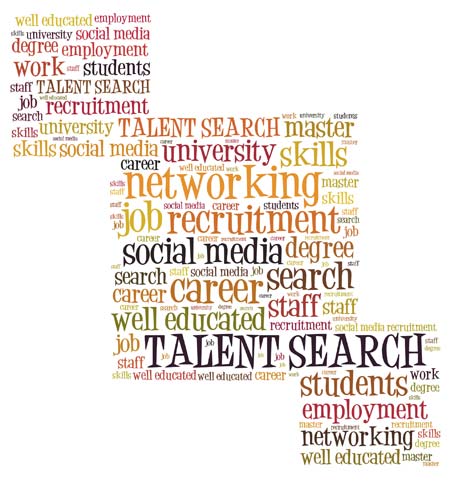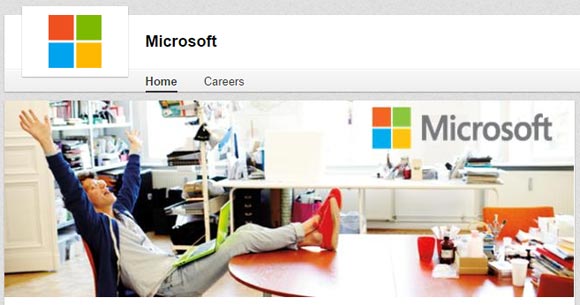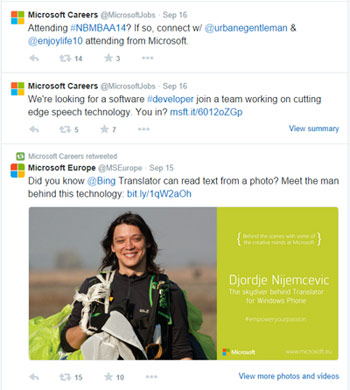I recently invited Carl Jones, founder and MD of Technically Compatible, to write a post for us about social media recruiting. Technically Compatible offer online skills testing software for recruitment.

Over to you Carl!
The permeation of social media into society has drastically altered the way individuals and companies interact with one another. There are now a myriad of channels at a brand’s disposal to get their message across. Recruitment in the digital age often has more in common with marketing best practice rather than recruiting. How do you make sure that your company stands out on social media? In this post we take a look at how Microsoft, as one of the biggest global players in the technical sector, is harnessing the power of getting social.
What’s clear from examining Microsoft’s strategy is that shifting the bulk of your recruitment experience online does not necessarily have to result in a less human, impersonal experience for the end user. In fact, the Redmond powerhouse has been careful to craft a careers experience that is all about you, the individual, however you choose to engage with the brand. In terms of their presence across social media, they have official channels on LinkedIn, Facebook, Twitter, YouTube and Instagram. Each channel subtly portrays insights into what life is like at Microsoft. Here we address their strategy for each in turn.
LinkedIn Strategy
What is particularly clever about their LinkedIn page is that it is integrated as part of a mini-website on the networking site. The second tab of the main Microsoft company page is dedicated to careers updates.

This is an incredibly clever move by the company for two reasons. Firstly, it captures a much larger audience. To date the page has over 1.9 million followers. Furthermore, it stimulates a more passive interest in what opportunities are available, even if members have no intention of changing role. Over 75% of candidates are considered passive, i.e. not looking for a new opportunity, thus having access to this pool of talent cannot be undervalued. It also prevents the members’ employer from having a panic attack that they have started following ‘Microsoft Careers’ (if they are connected to one another of course).
Facebook and Twitter Strategy
In terms of the updates that Microsoft share across their primary recruitment-specific channels, Facebook and Twitter, the tone is most definitely conversational. On their Facebook page they use audience targeting very effectively, directing questions at subsets including students. One example asked what would be the number one question they would ask the Microsoft university recruiter given the chance.
Once a week they package together their new opportunities as a ‘Hot Jobs’ update on both Facebook and Twitter, which links to an online newsletter in a new tab, rather than overloading the feed with individual job postings. This is a handy separator between those who are interested in the employer’s brand and those who are actively seeking an opportunity.
With regards to their Twitter approach, Microsoft craft a range of updates which are all very current, related to events, technical news and new opportunities as at a point in time. Take these three snippets for example:

What is evident is that their tweets address the reader in the first person. It may seem a simple strategy but it is often one that is missed.
On social media visual content is king. Earlier this this year Media Blog analysed over 2 million tweets sent over the course of a month by thousands of users. The results highlighted that photos can boost the number of retweets a post receives by 35%. People are not going to engage equally with every tweet you send but there are ways you can chivvy them along. The retweeted Microsoft Europe is a nice example of supplementing a short tweet with an image that gives extra context and visual interest to the message.
YouTube
Microsoft’s focus on visual imagery doesn’t begin and end with their Facebook and Twitter profiles. They have over 3,000 subscribers to their YouTube channel, with their site adopting similar design principles to their LinkedIn page. Providing segmented content via a number of different tabbed streams, such as ‘A Day in the Life’ and ‘Working and Microsoft UK’. They also use the front page to highlight their other YouTube channels, seamlessly allowing you to subscribe to other content without leaving the current page.
One of the popular misconceptions with video production is that it is expensive to produce. The majority of us now carry around video technology everywhere we go via our smartphones. A few simple add-ons such as a tripod, ambient light and some editing software and you can create professional videos that are proven to improve engagement by 28%.
Instagram Strategy
A further tool that can integrate short-form video content is Instagram. Microsoft were an early adopter of this channel, with their Life at Microsoft account currently amassing 1,690 followers and 101 posts. This channel allows brands to highlight their company culture in a more informal way to Twitter and Facebook, highlighting the less ‘photo-shopped’ take on day to day life.
General levels of engagement for Microsoft are excellent on this platform, with an average of 75 ’Likes’ per post, equating to an interaction percentage of 7.5%. This is considerably higher than their Twitter and Facebook interaction, which typically see circa 50 ‘Likes’ per post on Facebook out of a potential reach of over 392,000, and less than 10 RTs per tweet from their 48,000 Twitter followers. Company pages on Instagram are still in their infancy, but with the service recently launching sponsored updates in the UK, their prevalence is likely to increase significantly over the next few years.
Best practice in summary
As clichéd as it sounds, Microsoft’s online presentation really does have something for everyone. Their channels all connect with one another as one seamless experience. This adds a layer of authenticity as they have a consistent personable approach to their updates and most vitally they are building communities of advocates for their brand. They have also invested heavily in ensuring their careers website ties in with their social strategy. The site is in effect an extended social experience, with insights in their Talent Network and JobsBlog. This is their shop window once people convert from passive to active and it has to reflect the same values and style.
Additionally, they acknowledge that life at Microsoft is not going to be all things to all people. They recognise the importance of segmenting their audience’s needs with relevant content; be that by gender, location or stage in the career lifecycle. One instance of this is their work on diversity, which is interwoven with their main social presence as well as the provision of stand-alone channels to support this. They target their efforts on highlighting opportunities for women on Facebook, with a dedicated company page called Women at Microsoft, seen as a conscious effort to increase the diversity of their predominately white + male industry.
Microsoft is able to attract people across the world to follow its brand on social media because it links recruitment into its wider goals and objectives. Collaboration with marketing, business and product development teams ensures that the strategy is aligned with the company’s overall ambitions, instead of working as a separate entity. Microsoft operates in an incredibly fast-paced and competitive sector and their recruitment team has to employ a variety of tools to resonate with its audiences.
Modern recruitment is no longer defined by a location or a system. Social recruitment is all about marketing your employer offering to a wider audience. Companies need to provide potential candidates with relevant insight across multiple channels, to convert them from just browsing to buying in to your culture.
Thanks, Carl!
 Carl Jones is Founder and Managing Director of online IT skills testing company Technically Compatible. A business enthusiast, Carl has worked in the software industry for 10 years in a number of senior sales and management capacities. Before founding Technically Compatible, he was a board level executive of The Test Factory, helping achieve an 8 figure acquisition before moving on. Carl is a passionate entrepreneur with a keen interest in leveraging best of breed technology to launch disruptive businesses and has keynoted at several international conferences. Holding a Bachelors Degree from Newcastle Business School and an MBA candidate with Durham University, Carl believes in continual progress in himself as well as in his business.
Carl Jones is Founder and Managing Director of online IT skills testing company Technically Compatible. A business enthusiast, Carl has worked in the software industry for 10 years in a number of senior sales and management capacities. Before founding Technically Compatible, he was a board level executive of The Test Factory, helping achieve an 8 figure acquisition before moving on. Carl is a passionate entrepreneur with a keen interest in leveraging best of breed technology to launch disruptive businesses and has keynoted at several international conferences. Holding a Bachelors Degree from Newcastle Business School and an MBA candidate with Durham University, Carl believes in continual progress in himself as well as in his business.
Lucy is Editor at Corporate Eye


